Olivia Boudreau's videos capture eyes, ears and minds
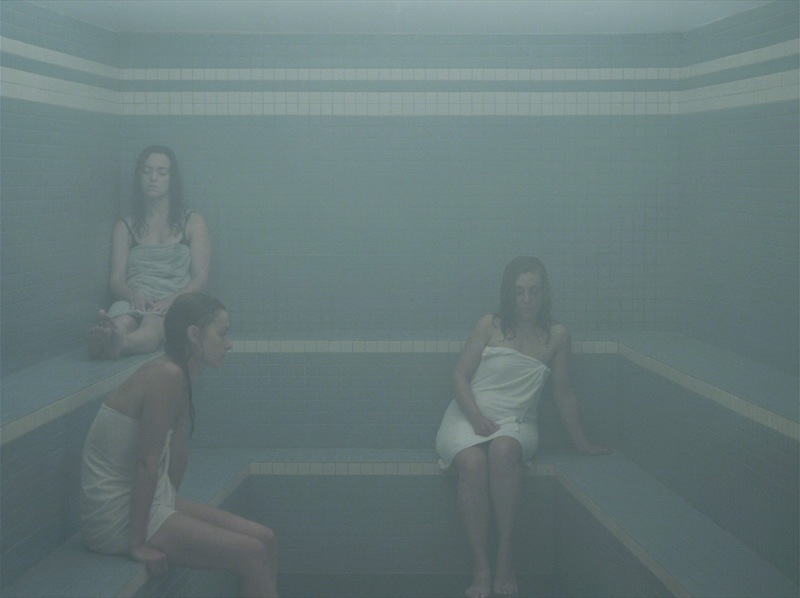
Despite a strong exhibition history in her native province of Quebec, including solo shows at the Darling Foundry and the Leonard and Bina Ellen Art Gallery, as well as her acclaimed inclusion in the 2011 Triennale Québécoise at the Musée d’art contemporain de Montréal, Olivia Boudreau’s practice has received little attention from English Canada. Working largely with single-channel, static, durational projections, she has taken up the format of early video artists and reinvigorated it. Simple and spare in their execution, her videos have a surprising depth of affect and emotional resonance, and are unequivocally beautiful. Earlier in November, on a blustery morning, Toronto-based critic Benjamin Bruneau met with the artist in her Montreal studio where they talked about how the immaterial becomes visceral in her work, installing her first exhibition in Toronto, and showing alongside the infamous “poop machine”.
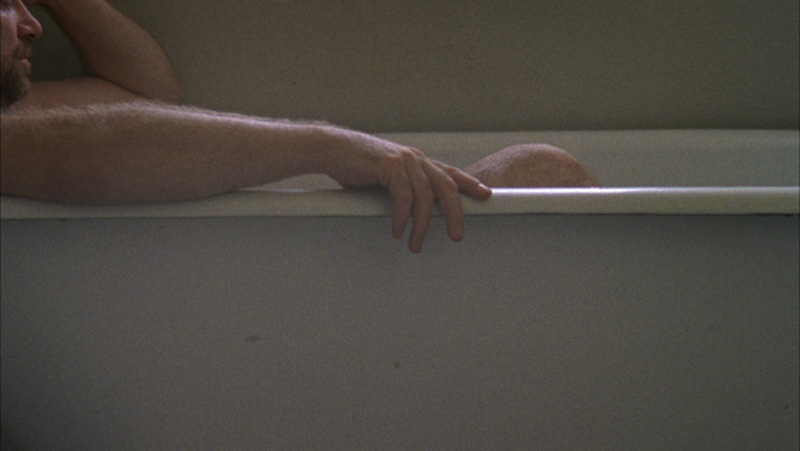
Benjamin Bruneau (B): I think your videos, though they can be quite long, are really about a moment. We think of moments as brief periods of time—wait a moment is the same as wait a second—but your moments can be 48 minutes, yet still the same space of consciousness.
Olivia Boudreau (O): I don’t expect people to be that concentrated. They can just be there for two minutes or an hour and a half—either way is enough. I think we don’t give our full attention to time, which is okay, but it results in a fluctuation of consciousness. That’s why my works are so slow, and not action-packed. You’re allowed to be inattentive, because I know that you will be, anyway. You can have a relationship with the piece where you don’t have to understand every second of it, but share a moment with it, feel its rhythm, its materiality.
B: It’s immediately obvious, though, that any part is exactly as important as any other part. You control the diagesis so tightly. But in that, you build such a strong sensorial relationship with the viewer. Everything you include makes it so bodily for the viewer to experience. How do you plan that kind of materiality?
O: I choose things like fur coats, that are clearly material elements. They have a clear texture that’s easy to recognize. I want my video to be very physical, to be alive. Even in my video The Relief (La Levée, 2008), the quality of the video itself, pixelated and grainy, has a deceptive physicality. I wanted it to have its own metabolism, something that we can meet as an equal.
B: Does your camera act as a body, then? Is it you, your eyes and ears?
O: I don’t know. When I make a video, I’m super-prepared. I know exactly the framing I want, and when it’s time to film, I know exactly what should occur. So I’m not in the physicality of the medium anymore. Actually, your question makes me realize that even tough it’s super important for me that the videos feel embodied, the process of making them is totally mental, virtual. The camera acts not so much as my body, but as my consciousness.
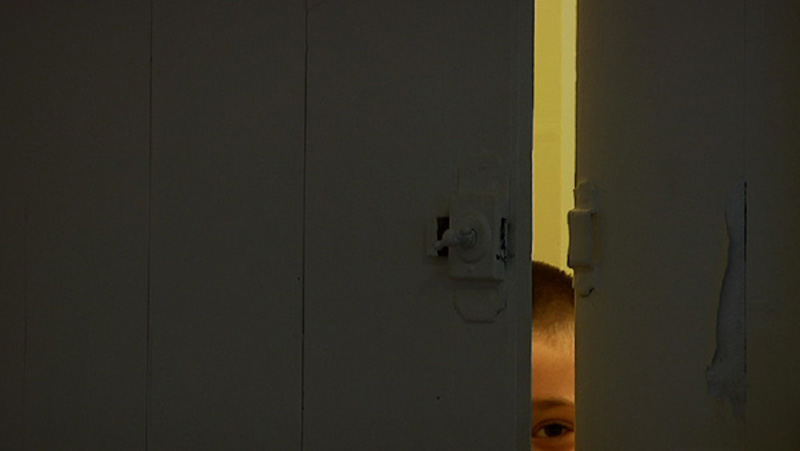
B: You used to be in your videos. You have a background in performance and dance, but you’re not in your more recent works.
O: At some point, I felt that I had done what I could. It was quite demanding, and I couldn’t do everything, and I felt that I had to invite something else, that I needed other people to bring some difference to the works before it got stale. If I kept going, I would have begun to repeat myself. It was quite a relief, honestly. When I invite people into my videos, I can find in them what isn’t in me. For The Steam Room (L’Étuve, 2011), I chose people who brought something with them, because of what they are. They each had character. It’s much more interesting to me than performing, because I come with particular significations. I have a presence, a way of being—who I am, how I act, and that’s a limitation at some point.
B: Performers do begin to have a style. Like Marina Abramović, or Andrea Fraser—you have a sense of what to expect.
O: They have a performance mode. It’s something that’s very present in art. But when you invite non-performers, they can’t be ‘neutral.’ You have to deal with what they are. I’ve begun rehearsals for a performance, and I’ve invited an actor and a performance artist. It’s so clear that the performance artist was comfortable, automatically, with this kind of neutral way of showing their body, this mode that is so recognizable to me. And the actor was trying all these things, trying to act, struggling with it. It was almost too much!
B: Your video works have something candid about them. They really look un-performed, like you’ve miraculously caught something real and unprepared and unbidden. You have a piece, called Your Piece (2007), where you’re crying, very similar to the Bas Jan Ader work, I’m too sad to tell you (1971). But it seems like it’s a mistake that the camera is on, because you’re turned away from the viewer. You’re pouring your heart out to someone offscreen, yet you can’t hear it, there’s no sound.
O: There’s narrative in sound, and it can be more narrative than the image. It’s almost dangerous. We are super-sensitive to sound, we expect answers from it. I need to be as minimal as possible, because even just a little bit of sound can be too evocative. There’s a lot of silence in my videos, because I want the viewer to bring their own narrative to the image. Most of the time I expect we’ll imagine the sound, hear it because we know how it should sound.
B: That almost makes the sound more present. You feel it instead. In Your Piece, when you swallow, your jaw moves and your neck flexes, when I see that I can hear it in my own body. The act is so comprehensible that I almost vocalize it myself. The architect Juhani Pallasmaa writes that the body has a memory for actions and sensations, so we know and understand, for instance, the softness of fur immediately when we see it. You have an incredible grasp of that material memory.
O: I did another piece with no sound at the Darling Foundry called Interior (Interieur, 2012). At the beginning of the project I had planned to include it, because I thought it would be amazing to have the sound of the textile and the wind, but a woman walks onscreen, and I realized that I would have to include the footsteps of the woman as well. And if that were so, you’d be able to follow her even outside the projection, before she was in the image, so I cut it out. Later, someone told me that she wished there was sound, that she didn’t have imagine it. And I thought, the sound you imagine is perfect!
Sometimes I try to have the sound work in opposition to the image. Like in The Relief, you can hear when you can’t see, and when you see you can’t hear. I select the sound very carefully, but try to keep it as minimal as possible.
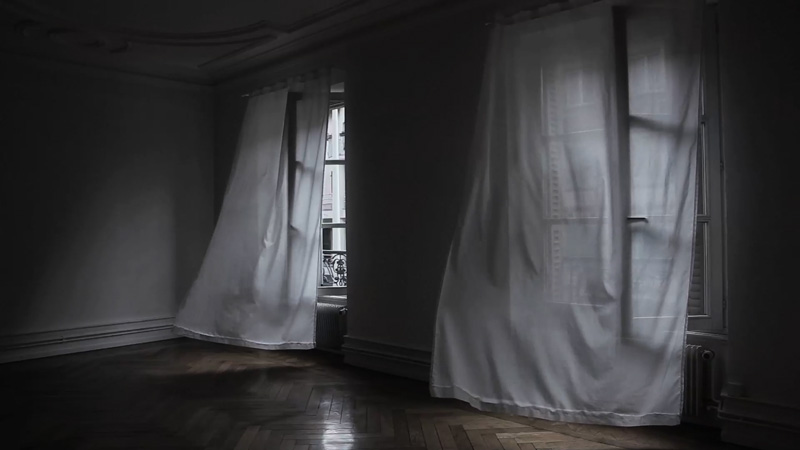
B: Pallasmaa also says that all our senses are really emanations of our haptic sense, of touch. To hear, for instance, is to feel the vibrations of sound waves on the tiny bones of our inner ears. Like in The Steam Room, the sound of the steam is so strong, it makes this recording of something that is insubstantial into a real force, an effect I can feel. It’s incredibly potent, bringing you into the room. Which is especially incredible, because it’s really not steam, is it?
O: No, it’s just three walls and a smoke machine.
B: It’s so beautiful, though. So in that scenario, the power of the sound was a real benefit.
O: I was really interested in this moment where, because of the steam, sound and materiality were the same. You can’t see and you can’t hear—it’s the steam and nothing else, not even the woman beside you.
B: How did you feel about the installation of it in Toronto at No Foundation?
O: I was kind of surprised. I’ve mostly shown in very sleek spaces. Every time, I manage to get a room for myself, to give the work space and a frame. I feel that the videos are fragile, because nothing much happens in them. I feel like I have to protect them a little bit and preserve their intimacy. So at the beginning of the installation, I wasn’t sure how we would do that in the No Foundation space. But at the end, I liked it a lot! I felt that it could really stand for itself.
I remember that when I showed Coats (Pelages, 2007) at Galerie UQAM I shared the gallery with (Belgian artist) Wim Delvoye’s piece Cloaca (2000–2007)—do you know it?
B: Yes, the poop machine that eats and actually digests things.
O: Exactly. I shared the gallery with the poop machine! There was a lot of buzz around it. I mean, TV crews came—TV crews don’t go into galleries, but for the poop machine, they do. So I spoke to Louise Déry (director of Galerie UQAM) about building a light trap because I wanted to push it away. I wanted to isolate myself from it. I thought the piece wouldn’t survive the poop machine. But Louise Déry said, “If the piece is strong enough, it’ll stand by itself.”
B: That’s hardly fair, because they’re not judged by the same criteria.
O: In the end, I agreed with her. If it didn’t survive, maybe it wasn’t that interesting.
B: I thought it was wonderful at No Foundation, because the relation of myself to the women on the screen. The scale was right, and the room felt like an extension of the frame.
O: That’s what I wanted. Previously I showed it much bigger. I thought at some point that it was too big, that maybe it should have been smaller. I had the chance to have a really large projection, which was good, but it comes with all kinds of technical problems. With a small piece, you can have a relationship with it that is kind of equal. It doesn’t dominate you.
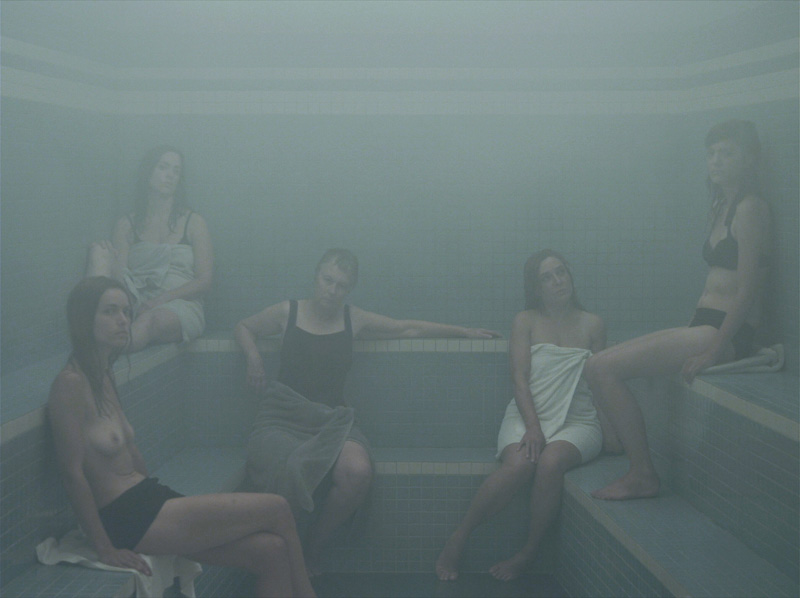
B: Because of that relationship of your work and the body, are you interested in engaging with the architectural?
O: Yes—Interior was much more a piece about space than duration. It’s about how the two images articulate themselves depending on the viewer in space, and the inability to connect them—they’re almost the same, and overlap a little, but they never line up.
B: It’s a kind of false room, like The Steam Room. They could be two different windows, but they’re really the same, removed in time. Interior is your only dual-channel video, as well. What prompted that decision?
O: It was a way to make a formal input into a process that was very controlled. Similarly, I did a piece called The Breach (La Brèche, 2012), with two sisters, which was edited, something I had never done before.
B: Will you be using that technique again?
O: It’s a bit early to tell. The most clear thing I can say is that my next video is about lying bodies and standing bodies, a woman lying down and people standing around her. There will be a performance with two people as well. I’m interested in a few stories I’ve heard recently about the death of the Virgin. In some representations, she’s an old woman. But at some point in art history, we stopped representing her as aged, as dying, and instead a 20-something young woman floating into the sky—the Assumption. This drew me to the anatomical theatre, where I learned that the audience would pay more to see dissections of women than men. It was good for business to do a woman. I’ve heard this explained by the fascination of the origin of life, the fascination of finding where in a woman we come from.
All those references won’t be in the piece itself, but they’re starting points for reflection.
B: So are you building an operating theatre?
O: No, I want something very minimal. I want a large space so we never feel the walls. I’ve visited some places, but the colour of the floor wasn’t right. That’s the problem when you’re kind of difficult, when you have precise idea of what you want.
B: But if you only make a few things that are exactly the way that you want them, I think that’s a good trade-off!
O: There are always compromises. Sometimes you have a precise idea, and then you find something better. It’s rare, but that’s the best.
Olivia Boudreau’s The Steam Room is on display at Katharine Mulherin Contemporary Art Projects/No Foundation in Toronto through December 22, 2013. Boudreau opens a solo exhibition at the Leonard and Bina Ellen Art Gallery at Concordia University in Montreal in February 2014.
Benjamin Bruneau is an artist and writer based in Montreal (Tiohtià:ke), on Mohawk and Abenaki land. He is the Reviews Editor of Magenta Magazine.



